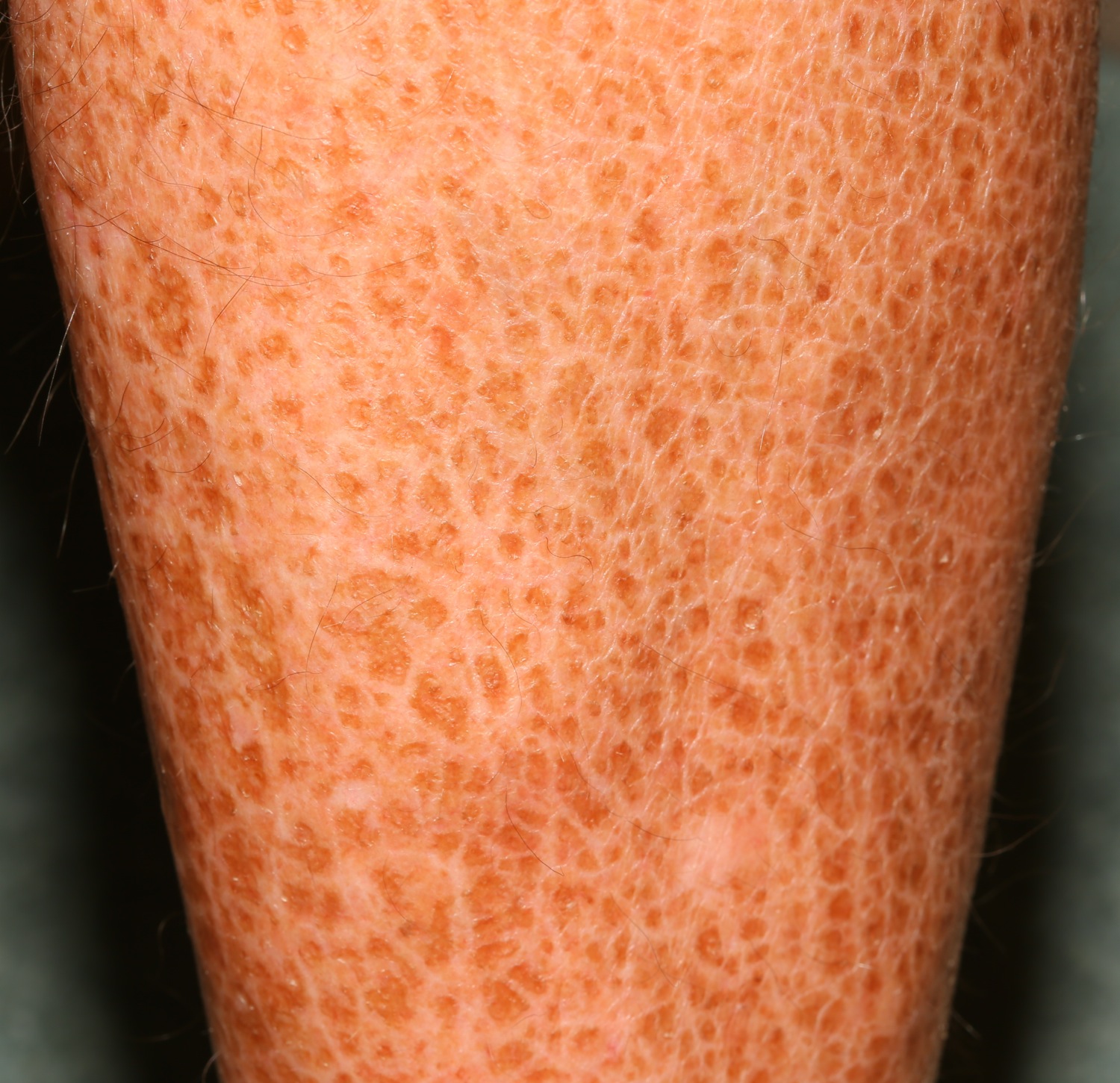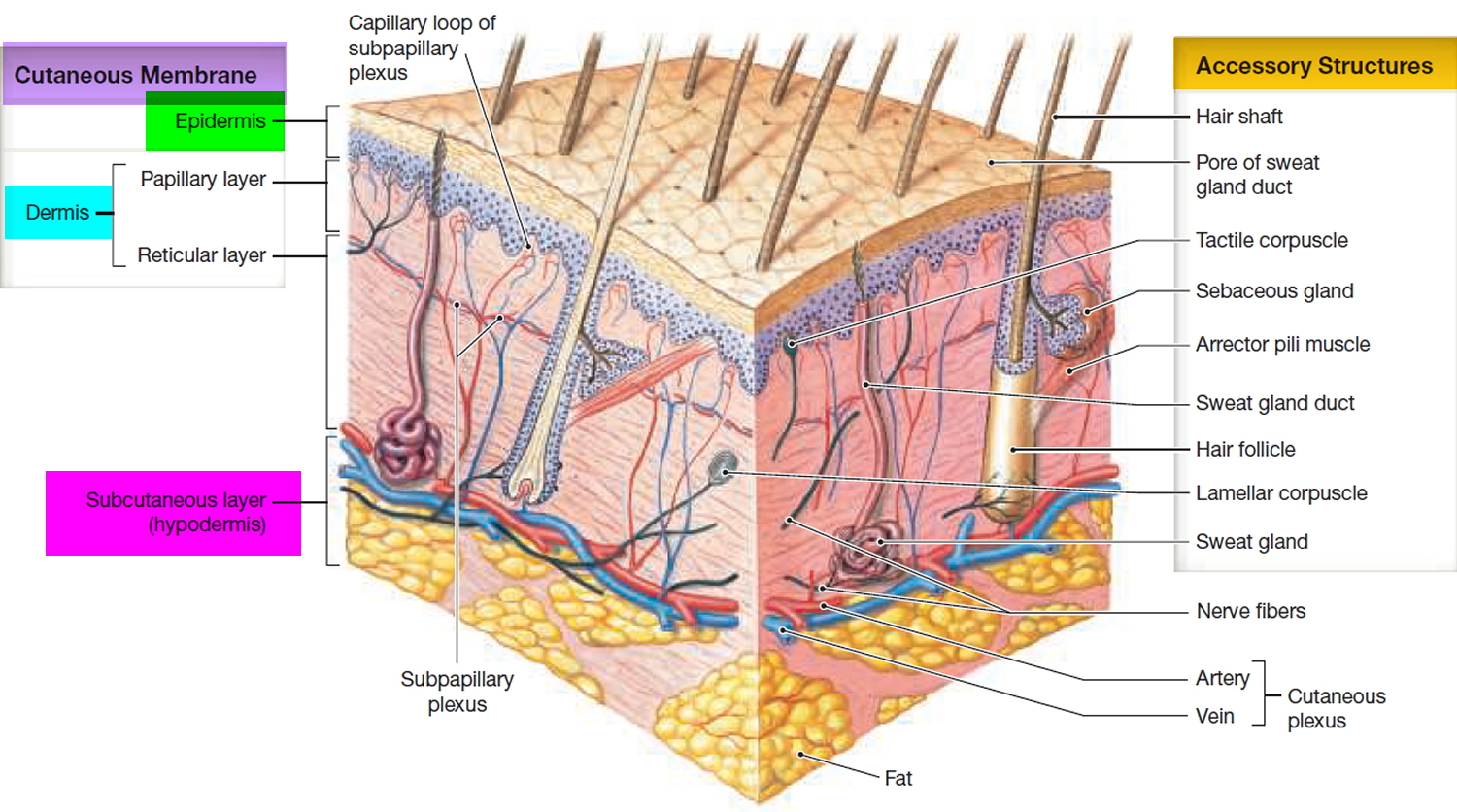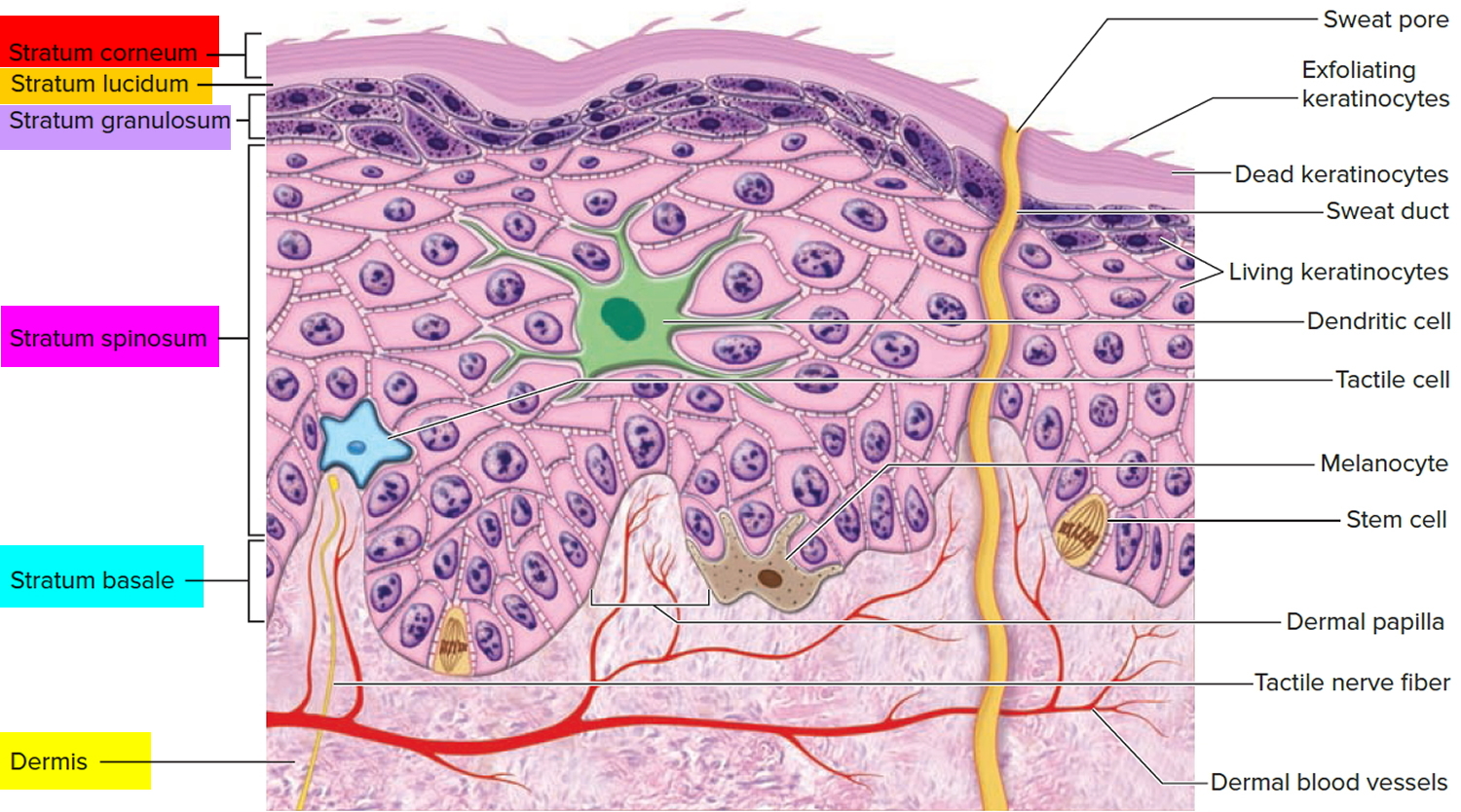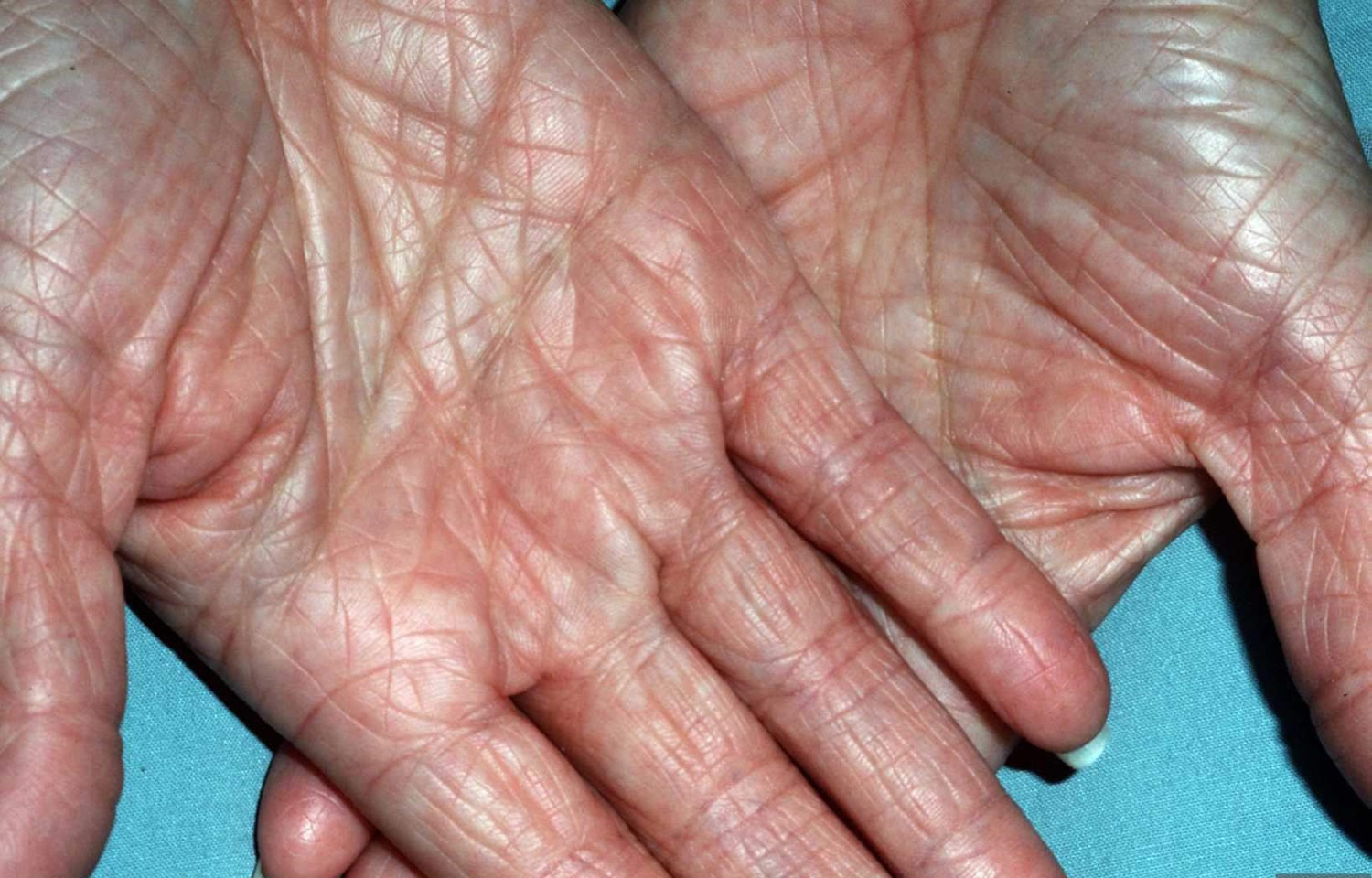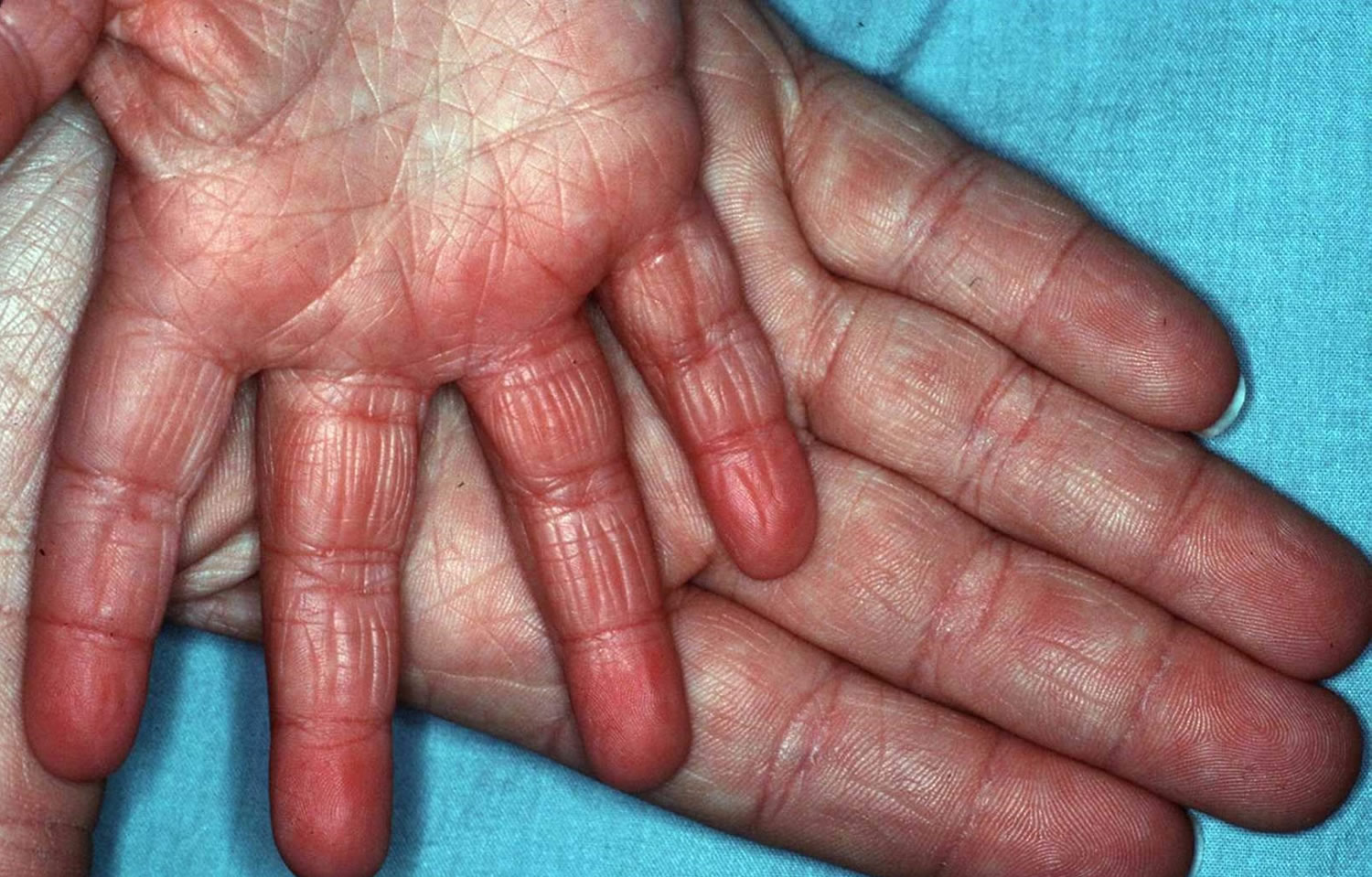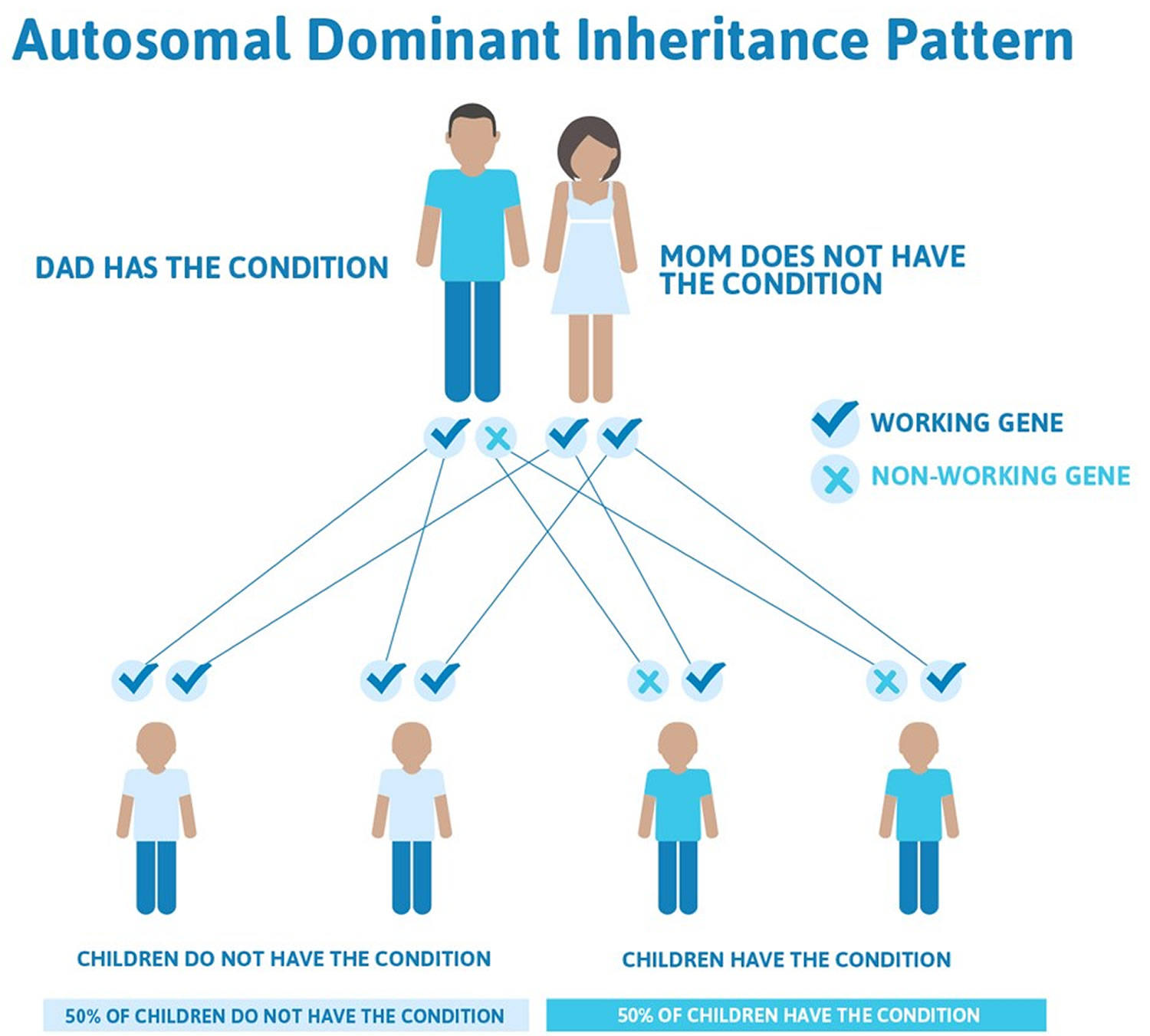Contents
What is ichthyosis vulgaris
Ichthyosis vulgaris also known as common ichthyosis, is an inherited skin disorder, characterized by excessive dry, scaly skin. Although ichthyosis vulgaris may be inherited (95% of cases) or acquired (5% of cases), it is usually not present at birth, but begins during the first year of life. The acquired type ichthyosis vulgaris usually develops in adulthood and results from an internal disease or the use of certain medications. The name “ichthyosis“ is derived from the Greek root “ichythys” meaning fish, to which ichthyosis vulgaris owes its other names, “fish scale disease,” or “fish skin disease”; “vulgaris” means common. Ichthyosis vulgaris symptoms in different patients vary in severity, from mild to severe. The scale is usually fine and white. Only a portion of the body may be involved, but scaling is most common and most severe on the lower legs (see Figure 1). Scaling on the torso is less severe and the face is usually unaffected. If the face is affected, the scaling is usually limited to the cheeks and forehead. The sides of the neck and the flexural areas are usually spared. Often, the skin on the palms of the hands and soles of the feet is thickened and may have exaggerated lines.
Inherited ichthyosis vulgaris is a fairly common disorder that affects approximately one in 250-300 persons in the United States. Males and females are affected in equal numbers. Each year, more than 16,000 babies are born with some form of ichthyosis. A recent study has determined that approximately 300 babies are born each year with a moderate to severe form of ichthyosis. On the other hand, acquired ichthyosis vulgaris is rare and is found almost exclusively in adults.
In inherited ichthyosis vulgaris, at least one of the affected child’s parents usually had the same dry, scaly skin as a child. It is inherited in an autosomal dominant fashion, meaning that each child of an affected parent has a 50-50 chance of having hereditary ichthyosis vulgaris.
A skin allergy or eczema (atopic dermatitis) may accompany ichthyosis vulgaris symptoms in approximately half of patients with this disorder. Ichthyosis vulgaris tends to improve with age. Hereditary ichthyosis vulgaris tends to improve after puberty. Symptoms can also improve in warm humid climates or during the summer months.
In ichthyosis vulgaris, the skin cells are produced at a normal rate, but they do not shed normally at the surface of the outermost layer of skin (stratum corneum) and are not shed as quickly as they should be. The result is a build-up of scale. Fine scales usually develop on the back and over muscles near the joints, such as an elbow or knee (extensor muscles). Ichthyosis vulgaris is usually most common and severe over the lower legs. The scale is usually fine and white. Scaling on the torso is less severe and the face is usually unaffected. If the face is affected, the scaling is usually limited to the forehead and cheeks. Often, the skin on the palms of the hands and the soles of the feet is thickened and may have exaggerated lines. Babies with ichthyosis vulgaris often appear normal when they are born, but the skin abnormalities will almost always begin to show up by their first birthday.
Treatment aims to reduce dryness, scaling, splitting and thickening of the skin. This is achieved with exfoliation and moisturizing on a regular, daily basis.
Treatments to keep the skin hydrated by applying emollients with high lipid content, such as lanolin cream (a sebum-like substance derived from wool-bearing animals).
Is there a cure for ichthyosis?
At present time there is no cure for ichthyosis. If you have inherited ichthyosis, you’ll have it for life. Acquired ichthyosis may get better if the underlying cause is identified and treated.
People with mild ichthyosis have a normal lifespan. However, the most severe inherited types can be life threatening.
Figure 1. Ichthyosis vulgaris
Figure 2. Skin structure
Figure 3. 5 layers of epidermis
Figure 4. Ichthyosis vulgaris hands
Ichthyosis vulgaris causes
Ichthyosis vulgaris is an inherited disorder transmitted through an autosomal dominant inheritance. In autosomal dominant inherited disorders, a single copy of the disease gene (received from either the mother or the father) will be expressed, dominating the other normal gene and resulting in the appearance of the disease. In the case of ichthyosis vulgaris, the gene for the disease overrides the gene for normal skin and the individual shows the disease. The risk of transmitting the disorder from an affected parent to offspring is 50 percent for each pregnancy, regardless of the sex of the child (see Figure 5 below). Severely affected individuals have mutations in both copies of the profilaggrin (FLG) gene, while people with only one copy of the mutated gene usually have a very mild skin problem.
Ichthyosis vulgaris results from loss-of-function mutations in the filaggrin (FLG) gene encoding the protein filaggrin (FLG), which is mapped on the epidermal differentiation complex on chromosome 1q21.3 (long arm [q] of chromosome 1 at position 21.3). The mutations lead to defective production of filaggrin.
The FLG gene provides instructions for making a large protein called profilaggrin, which is found in cells that make up the outermost layer of skin (the epidermis). Profilaggrin is cut (cleaved) to produce multiple copies of the filaggrin protein, which is important for the structure of the epidermis. The profilaggrin molecule can contain 10, 11, or 12 copies of the filaggrin protein, depending on the genetics of the individual. Further processing of the filaggrin protein produces other molecules that play a role in hydration of the skin.
The epidermis acts as a barrier to help minimize water loss and protect the body from foreign substances, including toxins, bacteria, and substances that can cause allergic reactions (allergens), such as pollen and dust mites. Filaggrin plays an important role in the skin’s barrier function. It brings together structural proteins in the outermost skin cells to form tight bundles, flattening and strengthening the cells to create a strong barrier and reduce trans-epidermal water loss. In addition, processing of filaggrin proteins leads to production of molecules that are part of the skin’s “natural moisturizing factor,” which helps maintain hydration of the skin. These molecules also maintain the correct acidity (pH) of the skin, which is another important aspect of the barrier.
Xerosis or dryness results from the reduced skin hydration associated with defective filaggrin. Excessive scale results from the inability of the squames (skin cells) to remain hydrated as they move upward through the stratum corneum. Hyperkeratosis results from compensatory repair mechanisms increasing cell proliferation.
Doctors frequently use genetic testing to help define which ichthyosis a person actually has. This may help them to treat and manage the patient. Another reason to have a genetic test is if you or a family member wants to have children. Genetic testing, which would ideally be performed first on the person with ichthyosis, is often helpful in determining a person’s, and their relative’s, chances to have a baby with ichthyosis. Genetic testing may be recommended if the inheritance pattern is unclear or if you or a family member is interested in reproductive options such as genetic diagnosis before implantation or prenatal diagnosis.
Results of genetic tests, even when they identify a specific mutation, can rarely tell how mild or how severe a condition will be in any particular individual. There may be a general presentation in a family or consistent findings for a particular diagnosis, but it’s important to know that every individual is different. The result of a genetic test may be “negative,” meaning no mutation was identified. This may help the doctor exclude certain diagnoses, although sometimes it can be unsatisfying to the patient. “Inconclusive” results occur occasionally, and this reflects the limitation in our knowledge and techniques for doing the test.
Figure 5. Ichthyosis vulgaris autosomal dominant inheritance pattern
Acquired ichthyosis vulgaris
The acquired ichthyosis vulgaris occurs in people with many internal conditions, including:
- Poor nutrition
- Infections, such as leprosy or HIV/AIDS
- Glandular diseases, such as thyroid or parathyroid problems
- Sarcoidosis
- Cancer, such as lymphoma or multiple myeloma
- Use of certain medications, such as nicotinic acid, cimetidine, and clofazimine
Ichthyosis vulgaris symptoms
Ichthyosis vulgaris is usually not present at birth. Most often it appears after about 2 months and in most cases before the age of 5. Symptoms may worsen up to puberty, and sometimes improve with age.
Ichthyosis vulgaris slows your skin’s natural shedding process. This causes chronic, excessive buildup of the protein in the upper layer of the skin (keratin). Symptoms include:
- Dry, scaly skin (xerosis) affects the extensor aspect of the limbs, scalp, central face and trunk. Skin folds are usually spared (neck, armpits, elbow and knee creases). There may be chapping (painful fissuring ) of palms and soles.
- Tile-like, small scales
- Scales colored white, dirty gray or brown — with darker-colored scales typically on darker skin
- Flaky scalp
- Deep, painful cracks in your skin
- Ichthyosis vulgaris is associated with keratosis pilaris (follicular hyperkeratosis) and hyperlinearity (pronounced skin lines) of palms and soles.
The scales usually appear on your elbows and lower legs and may be especially thick and dark over your shins. Most cases of ichthyosis vulgaris are mild, but some can be severe. The severity of symptoms may vary widely among family members who have the condition.
Symptoms usually worsen or are more pronounced in cold, dry environments and tend to improve or even resolve in warm, humid environments.
Atopic dermatitis (eczema) is present in 50% of people with ichthyosis vulgaris (and 8% of those with atopic eczema have the features of ichthyosis vulgaris). When atopic dermatitis is associated with severe ichthyosis vulgaris, the dermatitis tends to be early in onset, severe, and more likely to persist into adult life. There is also an increased risk of asthma, rhinitis and food allergy.
The most common locations for ichthyosis vulgaris include:
- Fronts of the legs (extensor surfaces of the legs)
- Backs of the arms (extensor surfaces of the arms)
- Scalp
- Back
- Forehead and cheeks, especially in younger children
The scales of ichthyosis vulgaris range in size from 1–10 mm and in color from white to gray to brown, with darker-skinned people often having darker scales. The legs are usually affected more than the arms. The creases on the palms of the hands and the soles of the feet are prominent and often crack during dry or cold weather. However, the scaling tends to improve in more humid or warmer weather.
The following areas tend to NOT be affected:
- Face
- Front of the neck
- Abdomen
- Folds in front of the elbows (flexural surfaces of the arms)
- Folds behind the knees (flexural surfaces of the legs)
Ichthyosis vulgaris tends to be itchy.
Ichthyosis vulgaris complications
Some people with ichthyosis may experience:
- Overheating. In rare cases, the skin thickness and scales of ichthyosis can interfere with sweating. This can inhibit cooling. In some people, excess sweating (hyperhidrosis) can occur.
- Secondary infection. Skin splitting and cracking may lead to infections.
- Impaired hearing or eyesight – if skin builds up over the ears or eyes.
- Limited movement – dry skin can make it too painful to move certain parts of the body.
People with severe ichthyosis may be prescribed retinoid tablets (synthetic vitamin A), which reduce the growth of overactive scaly skin. They improve the skin’s appearance, but don’t improve the inflammation or redness.
Vitamin D supplements may also be prescribed.
Ichthyosis vulgaris diagnosis
A doctor can often make a diagnosis by examining the affected skin and the characteristic scales. He or she may perform other tests, such as a skin biopsy. This may be necessary to rule out other causes of dry, scaly skin.
Filaggrin mutations can be detected by research laboratories from a buccal smear or saliva sample.
Ichthyosis vulgaris treatment
Ichthyosis vulgaris doesn’t have a known cure, so the goal of treatment is to manage the symptoms. The prognosis for a child with hereditary ichthyosis vulgaris is excellent, as most children improve after puberty.
Ichthyosis vulgaris should improve by restoring moisture (hydration) to the skin. Creams and ointments are better moisturizers than lotions, and they work best when applied just after your child’s bath, while the skin is still moist. The following over-the-counter products may be helpful:
- Preparations containing alpha-hydroxy acids such as glycolic acid or lactic acid
- Creams containing urea
- Over-the-counter cortisone cream (if the areas are itchy)
Any cracks in the skin should be treated immediately with a topical antibiotic ointment to prevent an infection.
Products containing urea, lactic acid or other alpha-hydroxy acids seem to help some individuals with ichthyosis. Some people get relief from pure lanolin, which is easier to spread when mixed with water.
- Try adding a few ounces of pure glycerin to your cream or lotion, and the skin will stay moist longer. Glycerin bought by the gallon is less expensive than smaller bottles. Most pharmacists will gladly special order a gallon for you.
- Scalp scales and dry scalp can be a problem for individuals with ichthyosis. The skin on the scalp thickens and scales just like the skin on the rest of the body. Removing the scales without removing the hair around them can be a challenge. The recommended way to treat scalp scales is to coat the scalp with your favorite lotion or oil to soften the scale, cover with a shower cap or plastic wrap and go to sleep; shampoo in the morning and brush or comb scales out after shampooing may help.
- Body odor can be a problem for people with ichthyosis. Regular bathing is helpful. Adding two teaspoons of bleach or vinegar to one gallon of bath water may help. The problem seems to come from bacteria trapped in the dead layers of skin.
- Bacterial infections can be a problem for some people with ichthyosis. Some individuals suggest adding two TEASPOONS of Clorox to one gallon of bath water. Carefully measure each gallon of water as you fill your tub and then mark the tub so that you can always fill with the same amount. For example, add 30 teaspoons of Clorox to 15 gallons of water.
- More baths are better. Water helps make dry skin easier to remove and makes people with ichthyosis more comfortable. Some people find salt and oatmeal baths soothing. Be sure to apply lotion or cream immediately after gently toweling dry.
- If you have problems with yeast infections in the groin area or feet, wear cotton underwear and cotton socks. Have your dermatologist prescribe the appropriate prescription medication for yeast or fungal infections. These problems need medical attention.
- Thick scale can sometimes harbor so much infection, causing bad odors, that an oral antibiotic may be needed. Some people remain on low doses of antibiotics for long periods to control infection.
- If you need to apply bandages, ask your pharmacist about some of the newest no-stick types.
- Natural fibers, such as wool or cotton, tend to wick moisture away from the body. You might consider cotton blends for clothing worn next to the skin. Some people with ichthyosis find rayon and other synthetics to be very irritating.
- Air conditioning and heating can be very drying, especially for small children. Fresh air, fans and humidifiers may prove to be more comfortable.
- Various cooling suits and devices are available for children and adults who cannot tolerate heat.
- Ear canals can be a problem when they become clogged with skin and wax. Be sure to have your child’s hearing checked routinely and check with your ear, nose and throat specialist for ways to properly clean the ears.
- Sunshine can work wonders for ichthyosis, but too much sun is dangerous. Always use a good sunscreen (broad spectrum SPF 30+), when outdoors.
Ichthyosis vulgaris treatment lotion
Ichthyosis vulgaris is usually treated topically with moisturizers containing urea or glycerol. Lotions containing alpha-hydroxy acids may help. However, some individuals with ichthyosis vulgaris also may experience atopic dermatitis (red, itchy patches of skin) and the alpha-hydroxy acids may irritate their skin.
Applying lotion and creams to wet skin seems to work better than putting them on dry skin. The lotion tends to trap the moisture.
Give any new cream or lotion a reasonable trial. Sometimes a product needs to be used for two or three weeks before results are noticeable. You may want to test the cream or lotion on a limited area of skin, like an arm or a leg, first.
Treatments your doctor may prescribe
To treat the dry, scaly skin of ichthyosis vulgaris, the physician may recommend a topical cream or lotion containing:
- Prescription-strength alpha- or beta-hydroxy acids (glycolic acid, lactic acid, salicylic acid)
- Prescription-strength urea
- A retinoid medication such as tretinoin or tazarotene (vitamin A-derived medications)
- High concentrations of propylene glycol
For more severe, stubborn ichthyosis vulgaris, oral treatments may include isotretinoin, a very strong medication with many potential side effects, usually used in the treatment of severe, scarring acne.
Retinoids, a prescription oral medication, have provided some patients with dramatic improvement. These drugs need to be closely monitored by your doctor as there are serious side effects.
Side effects from the vitamin A-derived medications may include eye and lip inflammation, bone spurs and hair loss.
- Retinoids may cause birth defects. Women considering retinoid therapy should be sure they are not pregnant before starting the medication — and use effective birth control while taking retinoids.
Recipes for Bathing with Ichthyosis or Related Skin Types
The following dermatologist-recommended recipes assume an average tub size of 90 gallons, filled to the brim. If you normally fill the tub one-third full before you get in, these are the amounts to use. Soak for a minimum of 30 minutes; one hour is better. Each of these baths should be followed by generous application of an emollient.
- Salt Bath for Removing Scale: Aim for as much as a 3% solution. This is just less than the amount of sodium chloride in the ocean. This equals 1/4 pound per gallon of water – or 5 lbs in 20 gallons or 7.5 pounds in 30 gallons. Less salt may work for some, if you soak for at least an hour. This is safe to use every day.
- Baking Soda Bath: Aim for a pH of 7.9. The amount of baking soda to add may vary with the quality (pH) of your tap water. In most cases, adding one-third cup to a tub one-third full with water will raise the pH to 7.9. You can test the water after the baking soda is dissolved with pH indicator paper. You must soak for 45 minutes to one hour before starting to gently slough scale with a washcloth, loofah or other gentle mechanical desquamator. Baking soda baths can be used up to several times a week.
- Antimicrobial Bleach Bath: Measure the amount of water usually put in the tub. Add 10ml (2 teaspoons) of household bleach per gallon – i.e., about 1 cup in a half-full tub (40-50 gallons). Soak for a minimum of 15 minutes – longer if you want to remove more scale. Bleach baths once or twice a week should be adequate to reduce odor and the frequency of infections; daily for one week may be necessary for someone currently infected. Remember, undiluted household bleach is quite irritating. Be careful how you handle it.
- Post Bath Emollient: It is important to use an emollient after bathing. If you have taken an alkaline bath (by using baking soda or bleach) it is a good idea to restore the natural acid pH of the outer layer of skin by using an emollient with a slightly acid pH, such as Lac-Hydrin or AmLactin.
Why do dermatologists recommend bleach baths to many of their patients with ichthyosis?
Many patients with ichthyosis, despite their best attempts at personal hygiene, become colonized by an overgrowth of bacteria, yeasts, or fungi. An unfortunate consequence of colonization by these microbes can be an unpleasant odor. When these same microbes try to reside on normal skin, they encounter a much thinner, and much more acidic stratum corneum. The ‘acid mantle’ of normal skin (pH 5.0 – 5.5) resists the growth of many microbes, while selectively encouraging colonization by the microbes that normally occupy the niche of the stratum corneum. In contrast to the low pH of normal skin, the pH of ichthyotic stratum corneum rises (to pH 6-7) due in part to excess scale, inflammation, and a defective barrier. This elevated pH and the thickened stratum corneum niche favor the overgrowth of many microbes, including not only those that populate normal stratum corneum, but also pathogenic microbes, such as Staphlococcus aureus.
The chief reasons dermatologists recommend bleach baths are to:
- Decrease Odor – Bleach baths reduce the amount of odoriferous colonization by potentially pathogenic microbes on the skin surface.
- Decrease Infection – Bleach baths can decrease the risk of infection.
However, there is a second consequence of the elevated pH of ichthyotic skin, and the even more elevated pH of bleach. There are enzymes in the stratum corneum that are more active at an elevated pH, and whose activity can have two important consequences:
- Separation of Cells – First, some of these enzymes degrade the connections that hold the cells of the stratum corneum together, causing these cells to separate from each other, and eventually to be shed from the skin surface. Obviously, for someone who has too thick a stratum corneum, bleach baths could prove to be an advantage. It should be noted, however, that there are no experimental or clinical data proving that bleach promotes desquamation.
- Inflammation – Second, some of the enzymes that are more active at higher pH can provoke inflammation, because they activate and release pro-inflammatory cytokines, proteins that normally are stored inside stratum corneum cells and shed harmlessly. Currently, there are no studies that address whether the slightly alkaline pH of bleach baths increases inflammation in those who have inflamed skin. Somewhat surprisingly, there is one study showing that dilute bleach has the ability to reduce inflammation in an animal model of inflamed (not ichthyotic) skin. So in sum, doctors still have questions about the impact that bleach baths have on inflammation in their patients.
Most of skin doctors would agree that, taken together, the benefits of bleach baths in reducing microbial overgrowth, odor and infections far outweigh the uncertainties arising from its slightly alkaline pH. Yet none would see any advantage to prolonged exposure to the abnormally high pH of dilute bleach baths for patients with ichthyosis. Instead, it would seem prudent to follow one’s bleach bath with a generous application of a slightly acidic emollient, such as amlactin or lachydrin, to help restore the skin’s natural acid mantle.
Skin infection
Some patients with ichthyosis are prone to recurrent fungal infections. These individuals may benefit from periodically taking an oral course of a systemic antifungal agent such as terbinafine. It is helpful to discuss this option with your doctor. It is also important in recurrent fungal infections to check your fingernails and toenails. Thickened fingernails and toenails could be a sign of persistent fungal infection of the nails which may be spreading to other parts of your body and leading to this infection recurrence. In cases of a fungal infection a quick in-office scraping by the dermatologist can let you know right away whether your skin is infected.
Exfoliation
Exfoliation is the act of removing the outer scales from the skin. For those individuals with hyperkeratotic ichthyosis (i.e. thickened skin) exfoliation can make you more comfortable doing day to day activities. However, exfoliation, while removing the scale, often brings out the underlying erythema or redness. So you may trade the scale for the redness. This is not an issue if the scale is very bothersome, but it is important to keep in mind if you do not want to be red. In other cases, such as Netherton syndrome, the skin barrier is impaired, and the skin should not be further exfoliated. Exfoliation will only lead to increased sensitivity and irritation in this case.
Tips for Exfoliation:
- After soaking in a tub for an hour or longer, use a wash cloth or loofah brush to gently remove the outer layer.
- After bathing, try using a cream or lotion with ammonium lactate, salicylic acid, or urea to help soften and exfoliate the outer layer.
- For those with thick scale under their eyes, topical tazarotene (a retinoid compound or vitamin A-derived medication) can loosen the scales and allow their eyelids to close more fully.
Tips for Exfoliation:
- Use baking soda and make a paste which would be considered a mild abrasive to aid in loosening the dead skin.
- Add Vaseline Bath Beads or apple cider vinegar to the bath water to help in softening up the skin before exfoliating.
- Let a loofah sponge soak in water for a few days before using, they will eventually soften up.
- When exfoliating areas such as knees, elbows and feet, if it starts to hurt, stop, and continue the next day.
- The salty ocean does wonders for the skin, and works as a natural exfoliant.
- Hydrotherapy, whereby the water and air is circulated throughout the tub, may also be a beneficial way to soften and exfoliate skin.
Ichthyosis vulgaris natural treatment
Self-help measures may help improve the appearance and feel of damaged skin. Consider these suggestions:
- Take long soaking baths to soften the skin. Use mild soap. Rub dampened skin lightly with a rough-textured sponge (loofa) or a pumice stone to help remove the scales.
- After showering or bathing, gently pat or blot the skin dry with a towel so that some moisture remains on the skin.
- Apply moisturizer or lubricating cream while the skin is still moist from bathing. Choose a moisturizer with urea or propylene glycol — chemicals that help keep skin moist. Petroleum jelly is another good choice.
- Apply an over-the-counter product that contains urea, lactic acid or a low concentration of salicylic acid twice daily. Mild acidic compounds help skin shed its dead skin cells. Urea helps bind moisture to skin.
- Use a portable home humidifier or one attached to your furnace to add moisture to the air inside your home.
